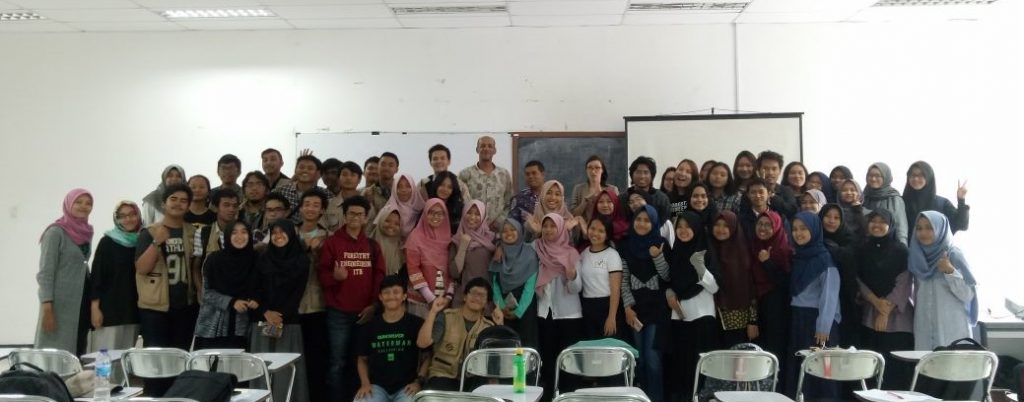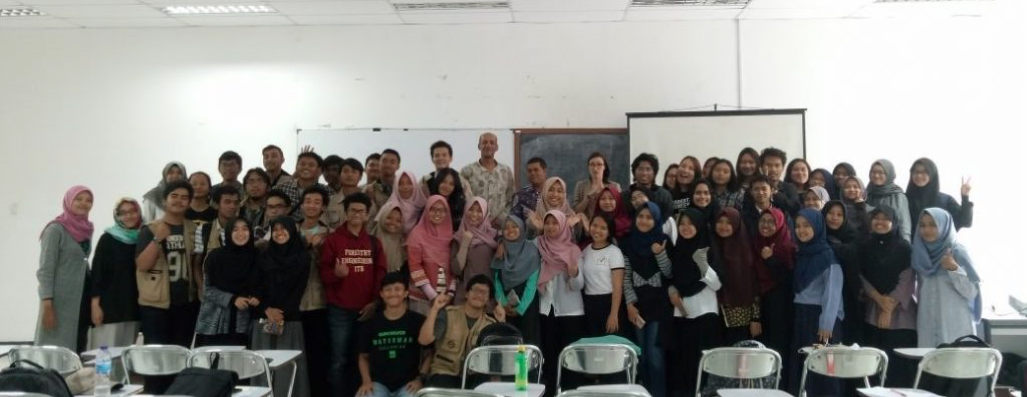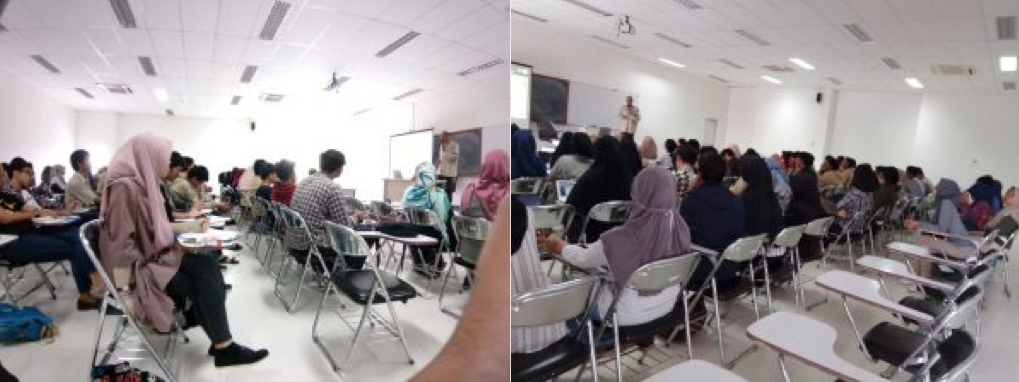[:id]Kuliah Tamu: Rites and Traditions of The PUNAN in Kalimantan[:en]Guest Lecture: Rites and Traditions of The PUNAN in Kalimantan[:]
[:id]Penulis: Vany Fadhilah, S.T

JATINANGOR, RK.SITH.ITB.AC.ID – Program Studi Rekayasa Kehutanan telah menyelenggarakan kuliah tamu bagi seluruh mahasiswa Rekayasa Kehutanan pada hari Rabu (18/04/2018) pukul 10.00 WIB – 11.30 WIB bertempat di Gedung Kuliah Umum (GKU 2) ITB Kampus Jatinangor. Acara ini dihadiri oleh sekitar 70 mahasiswa Rekayasa Kehutanan ITB, mahasiswa S2 Biomanajemen ITB, Ketua Prodi Rekayasa Kehutanan Dr. Elham Sumarga, Direktur French Institute of Indonesia (IFI) Melanie Martini-Mareel bersama staff dan Research Director of The French National Research Institute for Sustainable Development (IRD) Dr. Edmound Dounias selaku pembicara dalam acara ini. Kuliah tamu kali ini bertajuk Rites and Traditions of The PUNAN in Kalimantan.
Dr. Edmound Dounias menjelaskan bahwa PUNAN adalah salah satu rumpun suku Dayak di Pulau Borneo. Sebagian besar orang-orang PUNAN tinggal di Kalimantan, sebagian lain di Malaysia, dan sebagian kecil nomaden (berpindah-pindah tempat). Berdasarkan daerah tempat tinggal, orang-orang PUNAN terbagi menjadi dua yaitu PUNAN yang hidup di daerah perkotaan dan daerah terpencil. Mereka memiliki bahasa dan tradisi yang sama namun berbeda dalam hal lingkungan mereka hidup. Mereka yang hidup di daerah terpencil yaitu tinggal di dalam hutan dan sekitar hutan alam Kalimantan. Dibatasi oleh pegunungan dan perbukitan, mereka tidak memiliki akses ke perkotaan, tidak tersentuh oleh infrastruktur pembangunan, seakan terlupakan. Mereka benar-benar bergantung pada sumber daya hutan untuk memenuhi kebutuhan hidup dan memanfaatkan sungai sebagai sarana transportasi. Oleh sebabnya, mereka memiliki taraf kehidupan yang rendah dan tingkat kematian anak-anak yang tinggi.
Lebih lanjut dalam paparannya, Orang PUNAN memanfaatkan produk hutan sebagai sumber pendapatan. Fakta yang menarik adalah orang-orang pemanfaat produk hutan dan tinggal di daerah dekat perkotaan namun tidak terlalu jauh dengan hutan berpendapatan paling tinggi dibandingkan dengan orang yang tinggal di kota maupun orang yang tinggal di dalam hutan itu sendiri. Dengan begitu, ini menjadi salah satu perhatian bagi kita semua.
Selain itu, Dr. Edmound Dounias juga menjelaskan, Kalimantan erat dengan flora Dipterocarpaceae. Waktu berbuah Dipterocarpaceae tidak teratur dan tidak dapat diprediksi. Namun, babi liar (wild boar) dapat mendeteksinya. Babi liar berpindah-pindah dari satu patch ke patch lain untuk mencari Dipterocarpaceae yang sedang berbuah. Babi liar memakan buah Dipterocarpaceae yang baru jatuh ke tanah, jika babi tiba terlambat maka buah tersebut sudah tidak dapat dimakan. Oleh sebabnya, babi liar memiliki kemampuan untuk mendeteksi waktu berubah pada waktu yang tepat. Di sisi lain, banyak kumpulan mamalia yang mengikuti jejak babi tersebut karena mamali-mamalia tersebut dapat memakan biji-biji lain yang terjatuh dari badan babi. Kondisi ini dimanfaatkan oleh orang PUNAN untuk berburu mamalia dan juga sebagai tanda posisi babi liar untuk diburu. Orang PUNAN senang berburu babi liar untuk memenuhi kebutuhan protein mereka. Daging babi diketahui memenuhi 50% kebutuhan protein masyarakat Borneo. Namun kini, babi liar sangat sulit ditemui disebabkan oleh deforestasi yang meningkat di daerah Kalimantan.
Terakhir, Dr. Edmound Dounias menyampaikan bahwa hutan, manusia dan hidupan liar (wild life) tidak dapat dipisahkan. Serta, aspek arkeologi, antropologi, ekologi dan konservasi biologi merupakan satu kesatuan yang perlu dipahami. Mahasiswa diharapkan dapat menjadi peneliti untuk mengungkap banyak hal proses alam yang masih banyak belum terungkap demi kesejahteraan umat manusia dan lingkungan yang berkelanjutan.
Kuliah tamu ditutup dengan ucapan apresiasi pembicara atas partisipasi aktif mahasiswa, dan apresiasi SITH atas kesediaan Dr. Edmound Dounias sebagai pembicara dan diakhiri dengan foto bersama.

 [:en]Author: Vany Fadhilah, S.T
[:en]Author: Vany Fadhilah, S.T

The Forestry Engineering Undergraduate Program has held a guest lecture for all Forestry Engineering students on Wednesday (18/04/2018) at 10.00 WIB – 11:30 WIB at the Public Lecture Building (GKU 2) ITB Campus Jatinangor. The event was attended by around 70 ITB Forest Engineering students, ITB Biomanagement students, Head of Forestry Engineering Study Program; Dr. Elham Sumarga, Director of the French Institute of Indonesia (IFI); Melanie Martini-Mareel with staff and Research Director of the French National Research Institute for Sustainable Development (IRD); Dr. Edmound Dounias as the speaker at this event. This guest lecture was titled Rites and Traditions of The PUNAN in Kalimantan.
Dr. Edmound Dounias explained that PUNAN is one of the Dayak clans on the island of Borneo. Most PUNAN people live in Kalimantan, others in Malaysia, and a small number of nomads (moving places). Based on the area of residence, PUNAN people are divided into two groups, PUNAN who live in urban and PUNAN who live remote areas. They have the same language and tradition but differ in terms of the environment they live in. Those who live in remote areas are living in forests and around the natural forests of Kalimantan. Restricted by mountains and hills, they have no access to urban areas, untouched by development infrastructure, as if forgotten. They really depend on forest resources to fulfill their living needs and use the river as a means of transportation. Therefore, they have a low standard of living and high child mortality rates.
Furthermore, in his presentation, PUNAN people use forest products as a source of income. An interesting fact is that income of people using forest products and living in areas close to urban areas but not too far from forest is the highest compared to income of people living in cities and living in the forest itself. Hence, this is one of our concerns.
Besides, Dr. Edmound Dounias also explained, Kalimantan is closely related to the Dipterocarpaceae flora. Dipterocarpaceae fruiting time is irregular and unpredictable. However, wild boar can detect it. Wild pigs move from one patch to another patch to look for Dipterocarpaceae which are fruiting. Wild pigs eat Dipterocarpaceae that just fell to the ground, if the pig arrives late then the fruit is not edible. Therefore, wild pigs have the ability to detect times of change at the right time. On the other hand, many groups of mammals follow the footsteps of these pigs because these mammals can eat other seeds that fall from the body of a pig. This kind of condition is used by PUNAN people to hunt mammals and also as a sign of the position of wild pigs to hunt. PUNAN people hunt wild pigs to meet their protein needs. Pork meat is known to meet 50% of the protein needs of the people of Borneo. But now, wild pigs are very difficult to find due to increased deforestation in the Kalimantan region. The last, Dr. Edmound Dounias said that forests, people and wild life cannot be separated. As well as, aspects of archeology, anthropology, ecology and conservation biology are one entity that needs to be understood. Students are expected to become researchers to uncover many aspects of the many natural processes that have not been revealed for the welfare of mankind and a sustainable environment. The guest lecture was closed with a speech from the speaker for the active participation of students, and SITH’s appreciation for Dr.’s willingness. Edmound Dounias as a speaker and ends with a photo.
 [:]
[:]

![[:id]Kuliah Tamu: Rites and Traditions of The PUNAN in Kalimantan[:en]Guest Lecture: Rites and Traditions of The PUNAN in Kalimantan[:]](https://rk.sith.itb.ac.id/wp-content/uploads/sites/167/2018/04/2-e1524212099996.jpg)